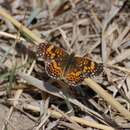pt-BR
nomes no trilho de navegação


Chlosyne gorgone ist ein Schmetterling (Tagfalter) aus der Familie der Edelfalter (Nymphalidae).
Die Flügelspannweite der Falter beträgt 32 bis 45 Millimeter.[1] Die Vorderflügeloberseiten sind gelbbraun bis braun orange gefärbt und haben ein Muster aus schwarzen Würfelflecken sowie einen breiten aufgehellten Querstreifen in der Postdiskalregion. Auf den Unterseiten der Hinterflügel sind abwechselnd braungelbe und helle Binden zu erkennen, die teilweise mit schwarzen Punkten ausgefüllt sind. In der Mitte der Hinterflügelunterseite befindet sich eine silberweiße, aus keilförmigen Zeichen gebildete Binde.[2] Dadurch unterscheiden sich die Falter von anderen Chlosyne-Arten.
Die Eier sind grünlich gefärbt. Sie werden in Gruppen auf der Unterseite der Blätter der Nahrungspflanze abgelegt.[3]
Junge Raupen sind nahezu einfarbig schwarz, Ausgewachsene haben eine orange oder gelbbraune Grundfarbe und eine breite schwarze Rückenlinie. Auf jedem Segment befinden sich schwarze Querstreifen, von denen dunkle, verzweigte Dornen ausgehen. Der Kopf ist glänzend schwarz.[4]
Die Puppe kann je nach dem Vorkommensgebiet in unterschiedlichen Brauntönungen auftreten und ist zuweilen mit sehr kleinen hellen oder dunklen Sprenkeln versehen. Sie ist als Stürzpuppe ausgebildet.
Das Hauptverbreitungsgebiet der Art reicht vom Südwesten Kanadas durch die mittleren US-Bundesstaaten bis in den Norden von Texas. In einigen US-Bundesstaaten und in Kanada kommt die Unterart Chlosyne gorgone carlota (Reakirt, 1966) vor. Die Tiere besiedeln bevorzugt offene Prärielandschaften.
Die Falter fliegen im Norden sowie in höheren Lagen in einer Generation von Mitte Mai bis Ende Juli, in der Mitte des Verbreitungsgebiets in zwei Generationen von Juni bis August und in den südlichen Regionen in mehreren Generationen von April bis September.[3] Sie saugen gerne an Blüten. Junge Raupen leben gesellig.[5] Sie ernähren sich von den Blättern verschiedener Korbblütlergewächse (Compositae), insbesondere von Sonnenblumenarten (Helianthus).
Chlosyne gorgone ist ein Schmetterling (Tagfalter) aus der Familie der Edelfalter (Nymphalidae).
Chlosyne gorgone, the gorgone checkerspot, is a species of Nymphalinae butterfly that occurs in North America.
The wingspan is between 32 and 45 mm. The dorsal side of the wings are orange with black markings and the hindwings have a submarginal row of solid black dots. The ventral view has a zigzag pattern of brown and white bands with a median band of white chevrons.
The gorgone checkerspot's range is in North America from Alberta east to southern Ontario, south into central Texas, between the Rocky Mountains and Appalachians. Within its range they can most commonly be seen in open areas including ridges, prairies and old fields. They can also be seen at streamsides and in open hardwood forests.
In the northern range there is one brood between July and August, two in the mid-range between May and September and three in the southern range between April and September. The females lay their eggs in clusters on the underside of their host plants. Early instar caterpillars feed in groups and third-instar caterpillars hibernate.
Chlosyne gorgone, the gorgone checkerspot, is a species of Nymphalinae butterfly that occurs in North America.
Chlosyne gorgone
Le Damier gorgone (Chlosyne gorgone) est une espèce de lépidoptères de la famille des Nymphalidae, de la sous-famille des Nymphalinae et du genre Chlosyne.
Chlosyne gorgone a été nommé par Jakob Hübner en 1810.
Synonymes : Dryas gorgone Hübner, [1810][1].
Le Damier gorgone se nomme en anglais Gorgone Crescentspot[1].
Le Damier gorgone est un papillon orange et noir de taille moyenne. Son envergure varie entre 32 et 45 mm Le dessus présente aux antérieures une bande marginale noire, une ligne de grands damiers orange, puis de petits damiers orange, alors qu'aux postérieures, fait suite à la bande marginale noire une bande submarginale de damiers orange centrés d'un point noir, puis la ligne de grands damiers orange comme aux antérieures et une partie basale foncée.
Le revers des antérieures est orange bordé de chevrons blancs alors que les postérieures sont argentées avec une ligne médiane de chevrons blancs[2].
La chenille est généralement noire, mais il existe une forme de couleur orange[3].
L'imago vole en juillet août en une génération dans le nord de son aire, en deux générations de mai à septembre au centre et en trois générations d'avril à septembre au sud de son aire[4].
Il hiberne au troisième ou au quatrième stade de la chenille[2].
Les plantes hôtes de la chenille sont diverses : Helianthus, Ambrosia trifida, Iva xanthifolia, Viguiera multiflora et pour la sous-espèce Lippia lanceolata, Lippia nodiflora, Helianthus annuus, Linaria vulgaris, Ambrosia trifida, des Lysimachia et des Eriogonum [1].
Il est présent en Amérique du Nord, au Canada en Alberta et Ontario, dans tout le centre des États-Unis, des Montagnes Rocheuses aux Appalaches, du Dakota du Nord au Texas et de l'Utah au Kentucky[1],[2].
Il réside dans les prairies[3].
Pas de statut de protection particulier[2].
Chlosyne gorgone
Le Damier gorgone (Chlosyne gorgone) est une espèce de lépidoptères de la famille des Nymphalidae, de la sous-famille des Nymphalinae et du genre Chlosyne.
Chlosyne gorgone is een vlinder uit de familie Nymphalidae.[1] De wetenschappelijke naam van de soort is voor het eerst geldig gepubliceerd in 1810 door Jacob Hübner.
Bronnen, noten en/of referenties